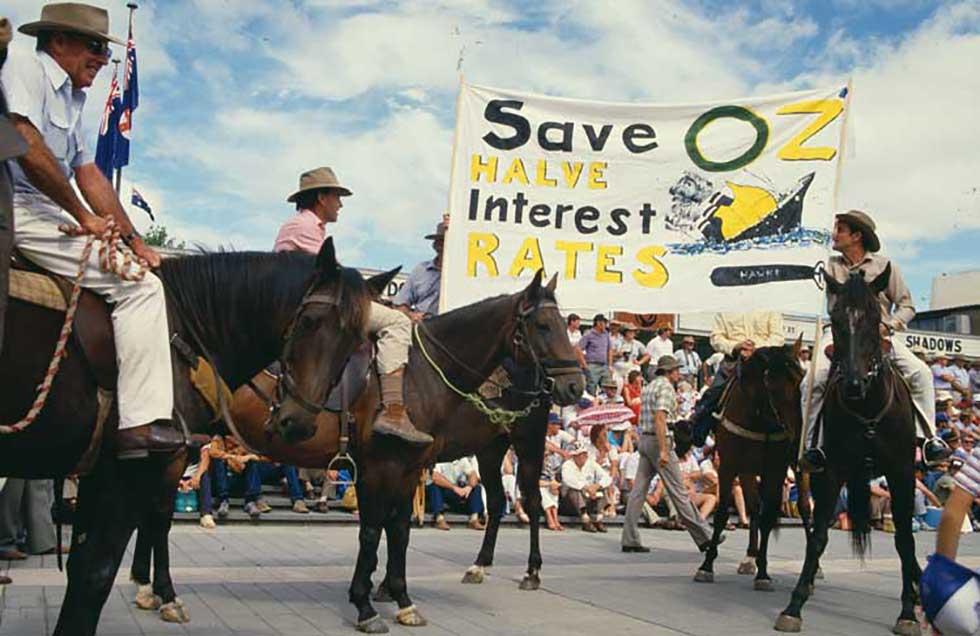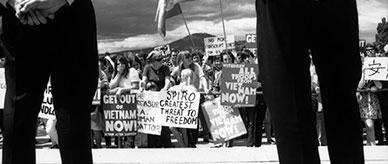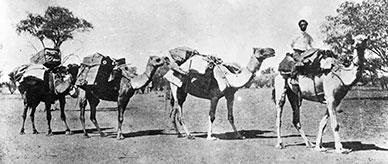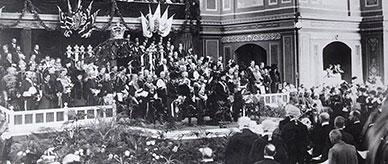


Transcript
[Photo of five men on horseback on a concrete-tiled street in an urban area. The men are wearing akubra hats and casual clothing, and the horses are standing still.
There is a crowd watching in the background, sitting and standing at the edge of the street. Australian flags are visible behind them.
Two of the men on horseback are carry a large banner, with the slogan 'Save OZ, HALVE Interest RATES'. The banner is illustrated with an outline map of Australia on the deck of a sinking ship, and a torpedo labelled 'HAWKE'.]
About the record
This is a coloured photograph taken of the 1985 farmers' rally in Canberra. It shows five men on horseback carrying flags and a banner.
Educational value
- Shows a rally organised by the National Farmers Federation, which had been established in 1979 – its policy document, Farm Focus, argued for the federal government to control inflation, enable wage flexibility and increase Australia's competitiveness in international trade, and called for the removal of protection from all industries including agriculture, and for increased efforts to break down trade barriers of other countries.
- Shows some of the 45,000 farmers, families and supporters who rallied outside Parliament House, Canberra on 1 July 1985, to protest about the effect of taxes and charges on the farming community and lack of government concern about their welfare.
- Shows one stage in the rally, recognised today as one of the biggest rallies in Canberra's history, sending a message to government about the need to reduce the high taxes and interest rates that were destroying rural business; it called on federal parliament to listen to a community that was disenchanted and disillusioned with the promises of politicians.
- Shows a banner calling for Australian interest rates to be halved – astronomical interest rates in the 1980s drove families into bankruptcy and many lost everything they owned – rates rose from 9 per cent in January 1980 to a peak of 17 per cent in 1989.
- Demonstrates a major concern of the farming community – the income of a farm is highly irregular because of seasonal variations, fluctuating prices, and pests and diseases, which means that the farmer cannot guarantee regular repayments to the bank, and the banks charge higher rates accordingly; farmers often paid interest rates of up to 25 per cent.
- Illustrates the general financial problems of the 1980s – these years were characterised by Australians investing heavily overseas, borrowing foreign money to pay for it, while foreign investors reduced investment in Australia; coupled with the deregulation of the financial market and removal of exchange controls, this resulted in massive foreign debt and high interest rates for all Australians.
- Is taken from a low angle to include the banner in the centre, framed by the farmers and their horses with the rest of the rally creating a backdrop.
Acknowledgments
Learning resource text © Education Services Australia Limited and the National Archives of Australia 2010.
Related themes
Need help with your research?
Learn how to interpret primary sources, use our collection and more.



